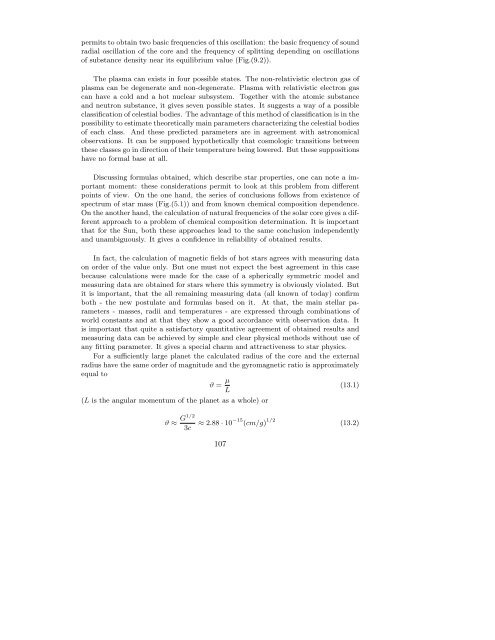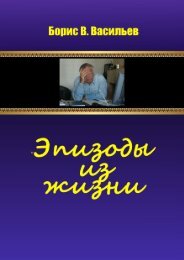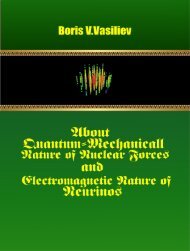VbvAstE-001
Book Boris V. Vasiliev Astrophysics
Book Boris V. Vasiliev
Astrophysics
Create successful ePaper yourself
Turn your PDF publications into a flip-book with our unique Google optimized e-Paper software.
permits to obtain two basic frequencies of this oscillation: the basic frequency of sound<br />
radial oscillation of the core and the frequency of splitting depending on oscillations<br />
of substance density near its equilibrium value (Fig.(9.2)).<br />
The plasma can exists in four possible states. The non-relativistic electron gas of<br />
plasma can be degenerate and non-degenerate. Plasma with relativistic electron gas<br />
can have a cold and a hot nuclear subsystem. Together with the atomic substance<br />
and neutron substance, it gives seven possible states. It suggests a way of a possible<br />
classification of celestial bodies. The advantage of this method of classification is in the<br />
possibility to estimate theoretically main parameters characterizing the celestial bodies<br />
of each class. And these predicted parameters are in agreement with astronomical<br />
observations. It can be supposed hypothetically that cosmologic transitions between<br />
these classes go in direction of their temperature being lowered. But these suppositions<br />
have no formal base at all.<br />
Discussing formulas obtained, which describe star properties, one can note a important<br />
moment: these considerations permit to look at this problem from different<br />
points of view. On the one hand, the series of conclusions follows from existence of<br />
spectrum of star mass (Fig.(5.1)) and from known chemical composition dependence.<br />
On the another hand, the calculation of natural frequencies of the solar core gives a different<br />
approach to a problem of chemical composition determination. It is important<br />
that for the Sun, both these approaches lead to the same conclusion independently<br />
and unambiguously. It gives a confidence in reliability of obtained results.<br />
In fact, the calculation of magnetic fields of hot stars agrees with measuring data<br />
on order of the value only. But one must not expect the best agreement in this case<br />
because calculations were made for the case of a spherically symmetric model and<br />
measuring data are obtained for stars where this symmetry is obviously violated. But<br />
it is important, that the all remaining measuring data (all known of today) confirm<br />
both - the new postulate and formulas based on it. At that, the main stellar parameters<br />
- masses, radii and temperatures - are expressed through combinations of<br />
world constants and at that they show a good accordance with observation data. It<br />
is important that quite a satisfactory quantitative agreement of obtained results and<br />
measuring data can be achieved by simple and clear physical methods without use of<br />
any fitting parameter. It gives a special charm and attractiveness to star physics.<br />
For a sufficiently large planet the calculated radius of the core and the external<br />
radius have the same order of magnitude and the gyromagnetic ratio is approximately<br />
equal to<br />
ϑ = µ L<br />
(L is the angular momentum of the planet as a whole) or<br />
(13.1)<br />
ϑ ≈ G1/2<br />
3c<br />
≈ 2.88 · 10 −15 (cm/g) 1/2 (13.2)<br />
107













